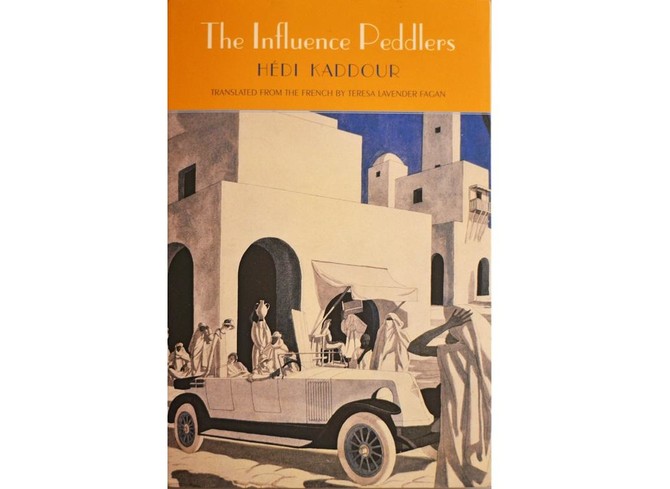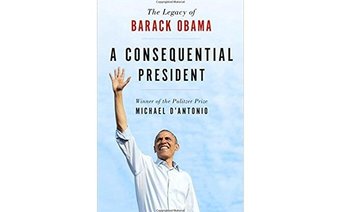The English-language translation of “The Influence Peddlers” by poet and novelist Hédi Kaddour has been eagerly anticipated since 2015 when he first published the book in French under the title “Les Prépondérants.” Translated into English by Teresa Lavender Fagan, Kaddour’s book received multiple awards for its clever plot that plays out in a small Maghrebi city that had been occupied by French colonial forces. It is a stunning book set in 1920s North Africa where natives, French colonialists, young reformers and Hollywood filmmakers descend, meet and ultimately impact each other’s lives.
Kaddour’s work is nothing short of genius. He navigates through the Maghreb, moving past the picturesque landscapes and diverse populations, highlighting colonial prejudice and mindsets, the bold ideas of young reformers and the ideas of educated youths who perceive colonization as oppression as well as the blasé attitude of those who find colonialism backwards, but do not regard it as slavery.
The book opens with 23-year-old Rania, the daughter of Si Mabrouk Belmejdoub, an important figure and former minister of the sovereign. Widowed at 19 after her husband dies in a shell attack in Champagne, her father pressures her to remarry. However, Rania finds that marriage will not fix her heartbreak, she needs something more, something she has been craving — control of her own life.
She is a woman who “read more books in Arabic than in French” and not only that, she is taller than most average men, something her father sees as a “handicap.” Sent to her uncle’s farm on the outskirts of Nahbés, a city in the south, Rania helps around the fields when her aunt takes ill. It is there that she begins to find herself among the farm, the fig trees and fields. She begins to read all of her uncle’s books, which makes him unhappy. “His niece wanted to know more than men, which wasn’t good for her or the family.”
The first sign of prejudice that Kaddour tackles in the book is that of gender, which he captures brilliantly and continues to reference throughout the book. For Rania, in the Maghreb, a woman who desires education and seeks to explore the world she lives in, is a danger to not only men, but to society. Such a woman is even perceived as a danger to French society, as educated natives are more dangerous than uneducated ones. If she is not content with living in the small box that she has been put into, she is a menace to herself and others. She reads newspapers and speaks of reform and people’s rights and her uncle is furious. For a woman to have thoughts such as these in a city occupied by colonizers is troublesome because, as her uncle knows, those kinds of ideas amount to nothing when an occupier stands over you.
The French, the colonials in particular, are “much more civilized than all these natives” and are the decision-makers in Nahbés. They have kept a fine balance in the city, “a dual city resting on a plateau on the shores of the sea and cut in two by a deep valley perpendicular to the shore; a city that for centuries occupied only the right side of the valley, the left side having been exclusively (occupied) by the French colonists,” who allow themselves to live freely and keep the natives under tight wraps by Senegalese soldiers who keep order by standing on the bridge that connects the cities. On the native side are walls, mosques and souks and on the European side, a post office, train station and Jules-Ferry Avenue.
The French are content with their way of life until the Americans arrive to film “Warrior of the Sands.” They are noisy and indiscreet, men and women sit together and women show too much skin and drive cars — it is enough to rattle the natives and the French. They look like the French, but are not like the French and may even be against colonialism.
What ensues after their arrival is a mix of ideas, cultures, prejudices, social upheaval and much more. There is a culture clash as the Americans invite the natives and the French to their parties and disrupt the existing social order. There you meet brilliant characters such as young Raouf, the caïd’s son and an activist, the American actress Kathryn Bishop and her director husband Neil Diantree, the French colonizer Ganthier and French journalist Gabrielle Conti.
Kaddour’s characters are brilliant in their perfection and simultaneous flaws. The situations they find themselves in, and the wit that ensues during these controversial events, is unadulterated. Kaddour’s book touches upon the many contradictions in society in the form of gender prejudice, racial discrimination, ageism and social prejudice.
Kaddour’s work is a take on Edward Said’s seminal book “Orientalism” in fiction form. The prevailing attitude is that of the oppressor who views natives as exquisite or rare because the idea that a native could be like a European is too unfathomable to believe.
The story is told through a beautiful mix of poetry, verse and literature from England, North Africa, Persia, the Middle East and France. Kaddour explores the complicated relationships that are to be had under colonization, the misinterpretations of cultures and the clarity that comes when you live without prejudice. His every character is allowed to observe and judge for themselves.
The power in the first few pages of Kaddour’s book is profound and continues to grow as the book moves forward and as readers encounter loved and much-hated characters. Politics drive the characters, their lives intertwined with their oppressors and their futures blocked by them.
Kaddour conveys the dangers of xenophobia and orientalism, of close-mindedness, isolation and the mindset of exclusivity. When the aim is to oppress, the outcome is never good. It is relevant because, even today, we can see that the consequences of colonialism are never-ending, nor is the entitlement of being from a particular race, culture, religion or family.
Kaddour’s book lays out the contradictions and misfortunes of powers that find strength in oppression. In the end, it amounts to heartbreak and delusion — the idea that the oppressed will turn around and love their oppressors and obey without question. Kaddour makes it clear in his book, as he writes, “you needed life in the illusion. Others were wrong in wanting to produce the illusion of life.”
Book Review: A powerful fictional take on Edward Said’s ‘Orientalism’
Book Review: A powerful fictional take on Edward Said’s ‘Orientalism’

What We Are Reading Today: ‘Breaking the Mold’

Authors: RAGHURAM G. RAJAN AND ROHIT LAMBA
India’s economy has overtaken the United Kingdom’s to become the fifth-largest in the world, but it is still only one-fifth the size of China’s, and India’s economic growth is too slow to provide jobs for millions of its ambitious youth.
In “Breaking the Mold,” Raghuram Rajan and Rohit Lamba show why and how India needs to blaze a new path if it’s to succeed.
What We Are Reading Today: ‘The Things You Can See Only When You Slow Down’

Author: Haemin Sunim
“The Things You Can See Only When You Slow Down: How to be Calm in a Busy World” offers advice on how to find inner peace in today’s busy world.
The 300-page book, published in 2017, was written by Haemin Sunim, a Korean Buddhist monk, and has sold more than 3 million copies.
The author underwent monastic training in South Korea before spending seven years teaching Asian religions at Hampshire College in the US. The book elaborates on the wisdom he gained from personal experiences as a Buddhist monk.
One of the book’s strengths is its simplicity. The author’s writing style is easy to understand as he presents his ideas in bite-sized chapters, each focusing on a different aspect of mindfulness.
Whether he is writing about the meaning of silence or of gratitude, Sunim’s words resonate with a quiet authority which prompts the reader to pause and reflect on their own lives.
In addition, the book is filled with amazing imagery that complements the stories. The beautiful drawings contribute to Sunim’s narrative and create a sense of serenity and peace.
The author emphasizes the concept of enjoying the little things in life to the fullest, such as drinking a cup of tea in the morning, taking a walk in nature, or having a thoughtful conversation with loved ones.
Slowing down allows people to notice the happiness hidden in even the simplest tasks and moments, he claims.
He also encourages readers to be kind to themselves and offers advice on how people can develop a deeper sense of self-acceptance and self-love, fostering emotional well-being and resilience.
Sunim’s wisdom and compassion are clear. His words remind readers that despite the noise and distractions of the modern world, true happiness can be found when they slow down.
What We Are Reading Today: Out of One, Many

Author: Jennifer T. Roberts
Covering the whole of the ancient Greek experience from its beginnings late in the third millennium BCE to the Roman conquest in 30 BCE, “Out of One, Many” is an accessible and lively introduction to the Greeks and their ways of living and thinking. In this fresh and witty exploration of the thought, culture, society, and history of the Greeks, Jennifer Roberts traces not only the common values that united them across the seas and the centuries, but also the enormous diversity in their ideas and beliefs.
Examining the huge importance to the Greeks of religion, mythology, the Homeric epics, tragic and comic drama, philosophy, and the city-state, the book offers shifting perspectives on an extraordinary and astonishingly creative people.
Century after century, in one medium after another, the Greeks addressed big questions, many of which are still very much with us, from whether gods exist and what happens after we die to what political system is best and how we can know what is real. Yet for all their virtues, Greek men set themselves apart from women and foreigners and profited from the unpaid labor of enslaved workers, and the book also looks at the mixed legacy of the ancient Greeks today.
The result is a rich, wide-ranging, and compelling history of a fascinating and profoundly influential culture in all its complexity—and the myriad ways, good and bad, it continues to shape us today.
What We Are Reading Today: ‘If Cats Disappeared from the World’

- Beautifully written and emotionally moving, it is also a testament to the power of storytelling and reminds people of the deep impact of making personal choices and connections
Author: Genki Kawamura
“If Cats Disappeared from the World” is a novel written by Japanese author Genki Kawamura. The book was published in 2012 and was rated 4/5 by over 75,000 readers worldwide.
Kawamura is a worldwide bestselling author. “If Cats Disappeared from the World” was his first novel, which sold over 1 million copies in Japan and was translated into over 14 languages.
In this novel, Kawamura tells the story of a postman who is diagnosed with an uncurable illness. However, when he accepts his destiny, the Devil appears to him with an unusual proposal. The postman must choose one thing to eliminate from this world for him to live one more day. During his journey, the postman then starts examining the true value of everything he owns.
Kawamura’s writing style is simple yet evocative, inviting readers to dive deep into the layers of their own emotional journey with every page. The narrative provides a delicate balance between moments of happiness and sorrow, using cats as a symbol of companionship and joy.
Moreover, the book allows readers to reflect on the value of relationships and experiences. It raises questions regarding the decisions people make, the legacies they leave behind, and the core meaning of everyday moments, which eventually shape people’s characters and how they think.
The novel encourages people to take a deep breath and reflect on the blessings people have, yet neglect, due to their busy lives.
With Kawamura’s thoughtful message and memorable characters, this novel is a compelling exploration of the human experience, providing comfort and inspiration, and a new appreciation for the beauty and brevity of life.
Beautifully written and emotionally moving, it is also a testament to the power of storytelling and reminds people of the deep impact of making personal choices and connections.
What We Are Reading Today: ‘Chinese Espresso’ by Grazia Ting Deng

Italians regard espresso as a quintessentially Italian cultural product—so much so that Italy has applied to add Italian espresso to UNESCO’s official list of intangible heritages of humanity. In this book, Grazia Ting Deng explores the paradox of “Chinese Espresso”— the fact that this most distinctive Italian social and cultural tradition is being preserved by Chinese immigrants and their racially diverse clientele.




















